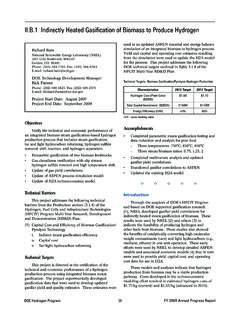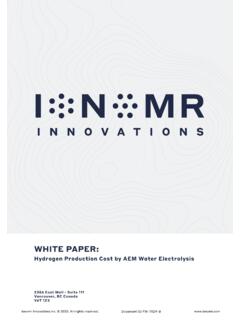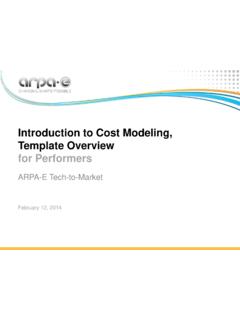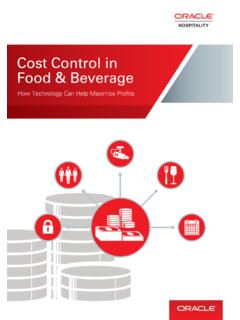Transcription of DOE Hydrogen and Fuel Cells Program Record
1 DOE Hydrogen and fuel Cells Program Record Record : 19009 Date: February 3, 2020. Title: Hydrogen production cost From PEM Electrolysis - 2019. Originators: David Peterson, James Vickers, Dan DeSantis ]. Peer Reviewed by: Kathy Ayers, Monjid Hamdan, Kevin Harrison Approved by: Katie Randolph, A Date: February 3, 2020. Eric Miller, and Sunita Satyapal a Item Rigorous stakeholder-vetted technoeconomic analysis was performed to assess the cost of Hydrogen produced using state-of-the-art polymer electrolyte membrane (PEM) electrolyzers if manufactured at scale. Projected high-volume, untaxed Hydrogen costs can range from approximately $2/kg-H2 to $7/kg-H2. based on industry input on PEM system performance as well as on capital, operational and feedstock costs.
2 The total uninstalled capital cost , for example, ranged from approximately $230/kW to $600/kW for different analysis scenarios. Analysis Summary The projected high-volume, untaxed cost of Hydrogen production from polymer electrolyte membrane electrolysis ranges from ~$ to $ , based on case study results using the Hydrogen production Analysis model2, version (H2A ). Four cases were analyzed, comprising two technology years (Projected Current [2019] and Projected Future [2035]), and two production capacities (Distributed [1,500 kg/day] and Central [50,000 kg/day])3. The case studies assume an electrolyzer manufacturers'. annual production capacity of 700MW/yr in order to model a robust and mature production scenario.
3 For reference, industry's production capacity at the time of publication is approximately 10MW/yr. The analysis presented in this Record supersedes the 2014 H2A PEM cases studies4, and uses recent input from, and reviews by, four independent manufacturers of PEM electrolysis systems to ensure the relevance and accuracy of the study parameters and results. Table 1- H2 production high-volume cost projections for the PEM Electrolysis Low Value Baseline High Value H2 cost at Case Study ($/kg H2) ($/kg H2) ($/kg H2) 3 /kWhelectric Distributed: Projected Current Case6 $ $ $ $ Projected Future Case7 $ $ $ $ Central: Projected Current Case8 $ $ $ $ Projected Future Case9 $ $ $ $ 1 Costs per kg of produced Hydrogen using 2016 dollars as the cost basis ( , reported as 2016$/kg H2).
4 2 H2A is a discounted cash-flow model providing transparent reporting of process design assumptions and a consistent cost analysis methodology for H2 production at central and distributed facilities 3H2A PEM Electrolysis Cases published at: : See Table 2 for a summary of case input parameters 4 Record #14004, ; See Supplemental Information for further details 5 All costs reported in 2016$/kg, consistent with H2A methodology which utilizes data from the Energy Information Administration (EIA) Annual Energy Outlook (AEO) 2017 Report (where 2016$ is the standard cost basis). 6 For this case, the effective electricity price over the life of the plant is /kWh 7 For this case, the effective electricity price over the life of the plant is /kWh 8 For this case, the effective electricity price over the life of the plant is /kWh 9 For this case, the effective electricity price over the life of the plant is /kWh 1.
5 Table 1 summarizes the cost projection results for Hydrogen production (untaxed, delivery, & dispensing not included) for the four cases. The baseline projections shown in the table capture representative system cost and performance based on averages of the manufacturer-supplied input incorporated into the technoeconomic analysis. Electricity prices for these baseline projections were taken from EIA AEO Reports with averages >$ The Low and High Values are included to reflect an expected cost spread (with 90% certainty) as determined by Monte Carlo multi-variable analysis. Special assessment of the system assuming a constant electricity price of $ , in line with the recent development of low cost electricity from renewable energy, is also shown in Table 1 and highlights the importance of electricity price on electrolysis-based H2 production .
6 Analytical Basis Four case studies centered on PEM-based electrolysis were performed using the H2A The four cases comprise two technology years: Projected Current (2019) and Projected Future (2035); and two production capacities: Distributed (1,500 kg H2/day) and Central (50,000 kg H2/day). Technology year is defined as the year in which a system design and electrolyzer cell/stack performance level have been demonstrated in the laboratory with high confidence that it can be translated to and developed into a full- scale system able to achieve the stated performance, durability, and cost targets. Projected Current cases reflect demonstrated state-of-the-art 2019 technology but manufactured at high production volume.
7 This differs from the existing commercial systems which are manufactured at significantly lower production rates using slightly older technology. Projected Future cases use advanced electrolyzer systems that will be technology-ready in 2035, with market entry assumed in 2040. Compared with the Projected Current cases, the Projected Future cases incorporate expected reductions in capital cost , electricity usage, and site preparation cost as well as increases in the stack replacement interval. Relevant technoeconomic data and information for the cases were solicited from four independent electrolyzer companies via questionnaire. Requested data included H2A input parameters needed for developing the cases as well as supplemental information for the documentation and vetting of the underlying technology assumptions.
8 Data collected fell into five primary categories: (1) engineering system definition; (2) capital costs; (3) operating costs; (4) variable and fixed expenses; and (5) replacement costs. The data and information were used as inputs for the four H2A case studies. For each case study, an engineering system performance model was developed from the baseline inputs to create a generalized electrolyzer system engineering design consistent with the diverse industry input from electrolyzer manufacturers. The engineering model was supplemented with a detailed ASPEN based model including economic analysis. The generalized electrolyzer system schematic is shown in Figure 1.
9 Based on the manufacturer inputs, literature review, and ASPEN design model, generalized system designs were developed for the Projected Current baseline cases that model electrolyzers operating at 2,000. mA/cm2 with a H2 outlet pressure of 300 psi. The generalized system designs developed for the Projected Future baseline cases were based on technologically-advanced electrolyzers operating at 3,000 mA/cm2. with a H2 outlet pressure of 700 psi. Capital costs11 for each case assume a production rate of 700 MW/yr 10 H2A is a discounted cash-flow model providing transparent reporting of process design assumptions and a consistent cost analysis methodology for Hydrogen production at central and distributed facilities.
10 H2A addresses cost scenarios where sufficiently high annual and cumulative volumes have been reached so that economies of scale for capital and unit costs have been achieved. Additional information can be found at: 11. All capital costs in this Record are inclusive of markup 2. and were developed through a combination of questionnaire responses, quoted equipment costs, and ASPEN model economic adviser. The ASPEN Economic Adviser projects costs for single item purchases of equipment. To align these equipment costs with manufacturing economies of scale of PEM operation (building enough production sites to handle a sum total of 700 MW/yr of input power), a cost reduction formula was applied to lower cost of equipment.
















